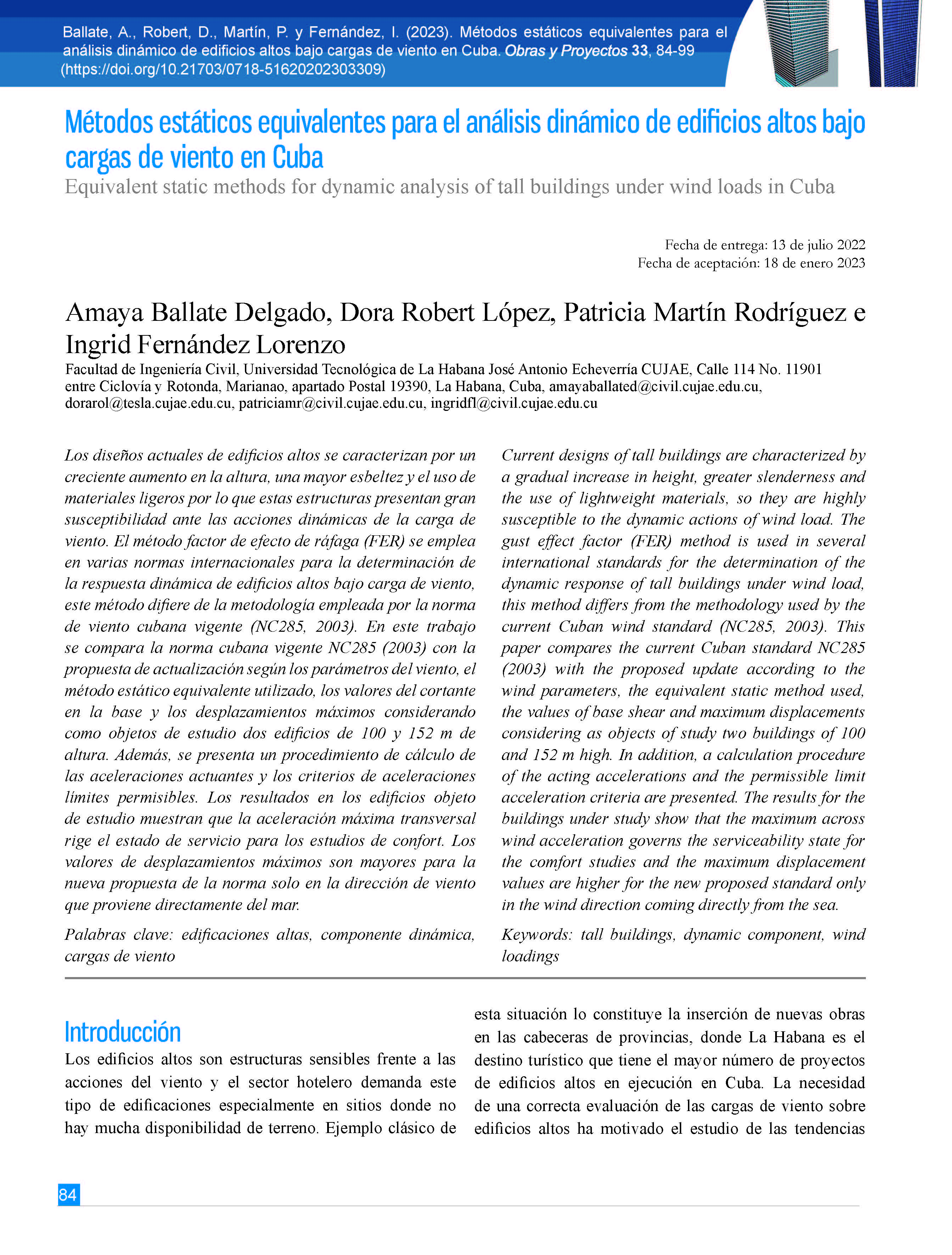Métodos estáticos equivalentes para el análisis dinámico de edificios altos bajo cargas de viento en Cuba
DOI:
https://doi.org/10.21703/0718-281320233309Palabras clave:
Edificaciones altas, Componente dinámica, Cargas de vientoResumen
Los diseños actuales de edificios altos se caracterizan por un creciente aumento en la altura, una mayor esbeltez y el uso de materiales ligeros por lo que estas estructuras presentan gran susceptibilidad ante las acciones dinámicas de la carga de viento. El método factor de efecto de ráfaga (FER) se emplea en varias normas internacionales para la determinación de la respuesta dinámica de edificios altos bajo carga de viento, este método difiere de la metodología empleada por la norma de viento cubana vigente (NC285, 2003). En este trabajo se compara la norma cubana vigente NC285 (2003) con la propuesta de actualización según los parámetros del viento, el método estático equivalente utilizado, los valores del cortante en la base y los desplazamientos máximos considerando como objetos de estudio dos edificios de 100 y 152 m de altura. Además, se presenta un procedimiento de cálculo de las aceleraciones actuantes y los criterios de aceleraciones límites permisibles. Los resultados en los edificios objeto de estudio muestran que la aceleración máxima transversal rige el estado de servicio para los estudios de confort. Los valores de desplazamientos máximos son mayores para la nueva propuesta de la norma solo en la dirección de viento que proviene directamente del mar.
Referencias
AIJ (2018). AIJ Recommendations for loads on buildings (2015). Architectural Institute of Japan, Tokyo, Japan.
ASCE 7-10 (2010). Minimum design loads for buildings and other structures. ASCE/SEI, Reston, Virginia, USA.
AS/NZS1170.2 (2021). Structural design actions, Part 2: Wind actions. Australian/New Zealand Standards, Wellington, New Zealand.
Ballate Delgado, A., Fernández Lorenzo, I. y Martín Rodríguez, P. (2021a). Aceleraciones inducidas por el viento en edificios altos. X Convención Científica Internacional de la Universidad de Matanzas, VII Taller Internacional de Ingenierías, Cuba.
Ballate Delgado, A., Fernández Lorenzo, I. y Martín Rodríguez, P. (2021b). Cálculo de las aceleraciones inducidas por el viento en edificios altos en Cuba. Revista Ciencia y Construcción 2(2), 23-32.
CNR-DT207 (2008). Guide for the assessment of wind actions and effects on structures. Italian National Research Council, Roma, Italy.
CSI (2018). ETABS v18. Computers & Structures, Inc. CSI. Structural and earthquake engineering software. USA.
Davenport, A.G. (1967). Gust loading factors. Journal of the Structural Division 93(3), 11-34.
Davenport, A.G. (1964). Note on the distribution of the largest value of a random function with application to wind loading. Proceedings Institution Civil Engineers 28(2), 187-196.
EN1991-1-4 (2005). Eurocode 1: Actions on structures — General actions — Part 1-4: Wind actions. Brussels, Belgium.
Fernández Lorenzo, I. y Elena Parnás, V.B. (2016). Análisis de métodos de vientos extremos para calcular las velocidades básicas. Revista Cubana de Ingeniería 7(2), 15-25.
García Miranda, J.A., López Litvinovich, A., Fernández Lorenzo, I. y Martín Rodríguez, P. (2019). Análisis de nuevos proyectos de edificios altos bajo carga de viento en La Habana. II Convención Científica Internacional, Universidad Central Marta Abreu de Las Villas, Cuba.
IS:875(Part-3) (2012). Wind loads on buildings and structures - Proposed draft & commentary. Document No IITK GSDMAWind 02-V 5.0. Indian Wind Code IWC, India.
ISO 4354 (2020). Wind actions on structures. International Organization for Standardization. Switzerland.
Kwon, D.K. and Kareem, A. (2013). Comparative study of major international wind codes and standards for wind effects on tall buildings. Engineering Structures 51, 23-35.
Longarini, N., Cabras, L., Zucca, M., Chapain, S. and Aly, A.M. (2017). Structural improvements for tall buildings under wind loads: comparative study. Shock and Vibration, article ID 2031248.
López Litvinovich, A., Martín Rodríguez, P. y Castañeda Hevia, A.E. (2018). Respuesta torsional de edificaciones bajo cargas de viento. Revista Arquitectura e Ingeniería 12(1), 1-13.
Luis García, K. (2017). Análisis estadístico de velocidades de viento para el cálculo de estructuras. Tesis de máster, Universidad Tecnológica de La Habana CUJAE, La Habana, Cuba.
Llanes Burón, C. (1988). Algoritmo para determinar las componentes dinámicas de las cargas de viento en edificios. Ingeniería Estructural IX(2), 113-120.
Llanes Burón, C. (1984a). Algunos criterios sobre el diseño de edificios altos. Ingeniería Civil (ISPJAE) 1, 16-28.
Llanes Burón, C. (1984b). Algunos métodos de análisis utilizados en edificios. Elementos paneles, tímpanos y pórticos interconectados. Ingeniería Civil (ISPJAE) 6, 24-30.
NBCC (2020). National building code of Canada. Canadian Commission on Buildings and Fire Codes, National Research Council of Canada, Ottawa, Ontario, Canada.
NC53-41 (1983, 1990). Elaboración de proyectos de construcción. Cargas de viento. Método de cálculo. Oficina Nacional de Normalización, La Habana, Cuba.
NC283 (2003). Densidad de materiales naturales, artificiales y de elementos de construccion como carga de diseño. Oficina Nacional de Normalización, La Habana, Cuba.
NC284 (2003). Edificacones. Cargas de uso. Oficina Nacional de Normalización, La Habana, Cuba.
NC285 (2003). Carga de viento. Método de cálculo. Oficina Nacional de Normalización, La Habana, Cuba.
SNiP2.01.07-85 (2001). Loads and effects. State Building Committee of USSR (Gosstroi of USSR). Moscow, USSR.

Descargas
Publicado
Número
Sección
Licencia

Esta obra está bajo una licencia internacional Creative Commons Atribución-NoComercial 4.0.







